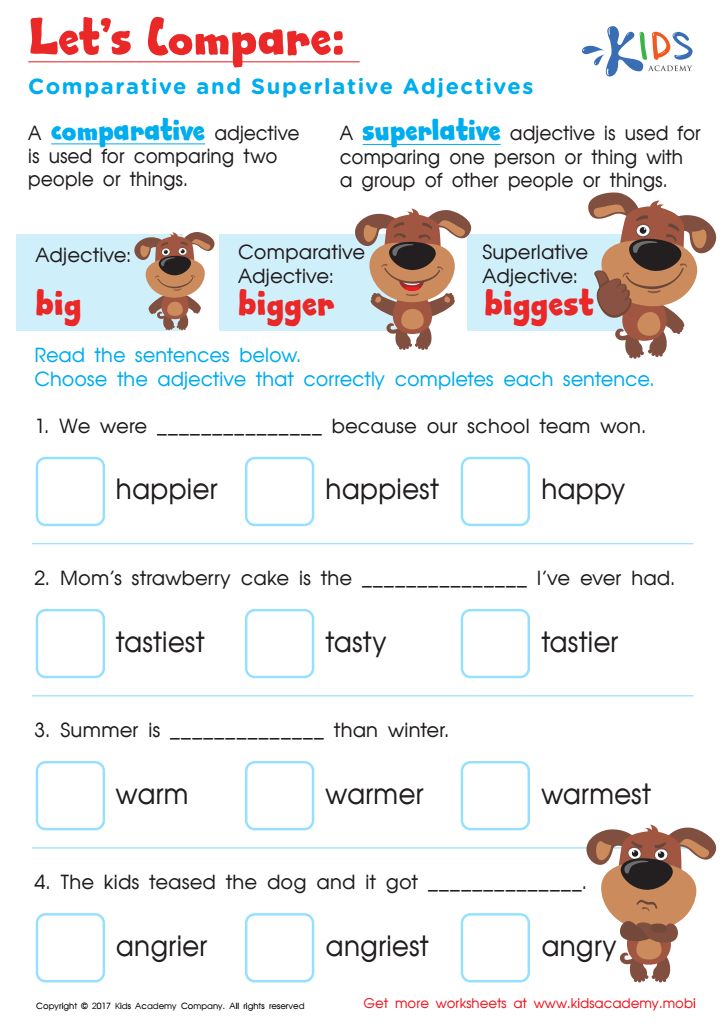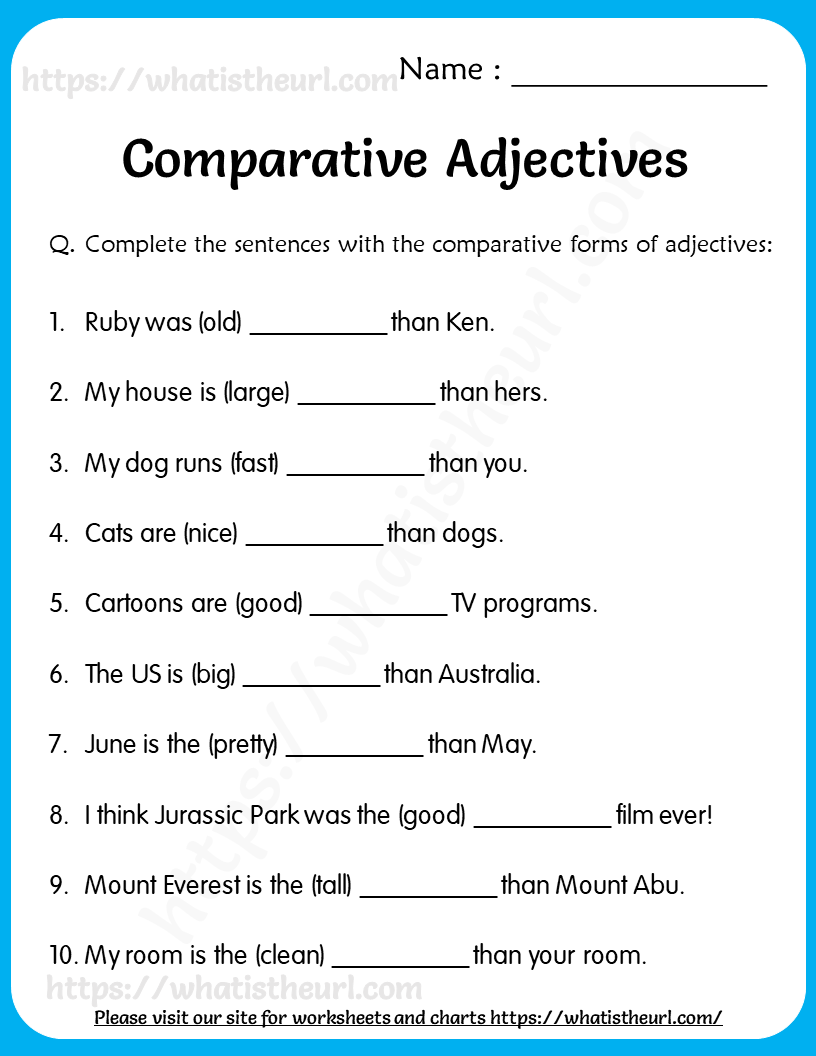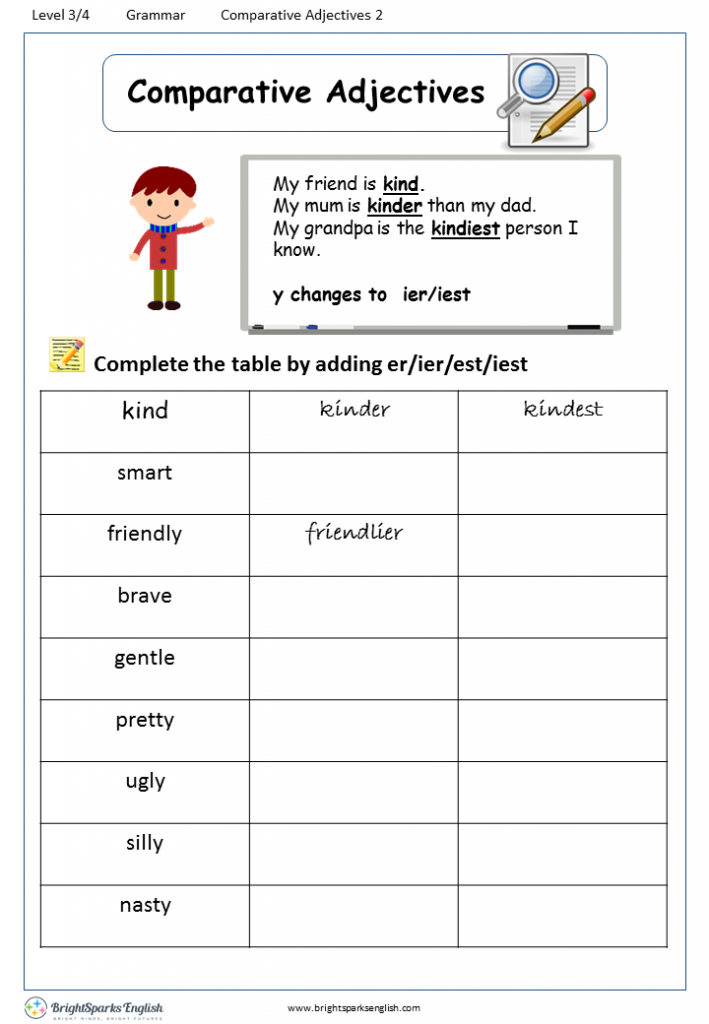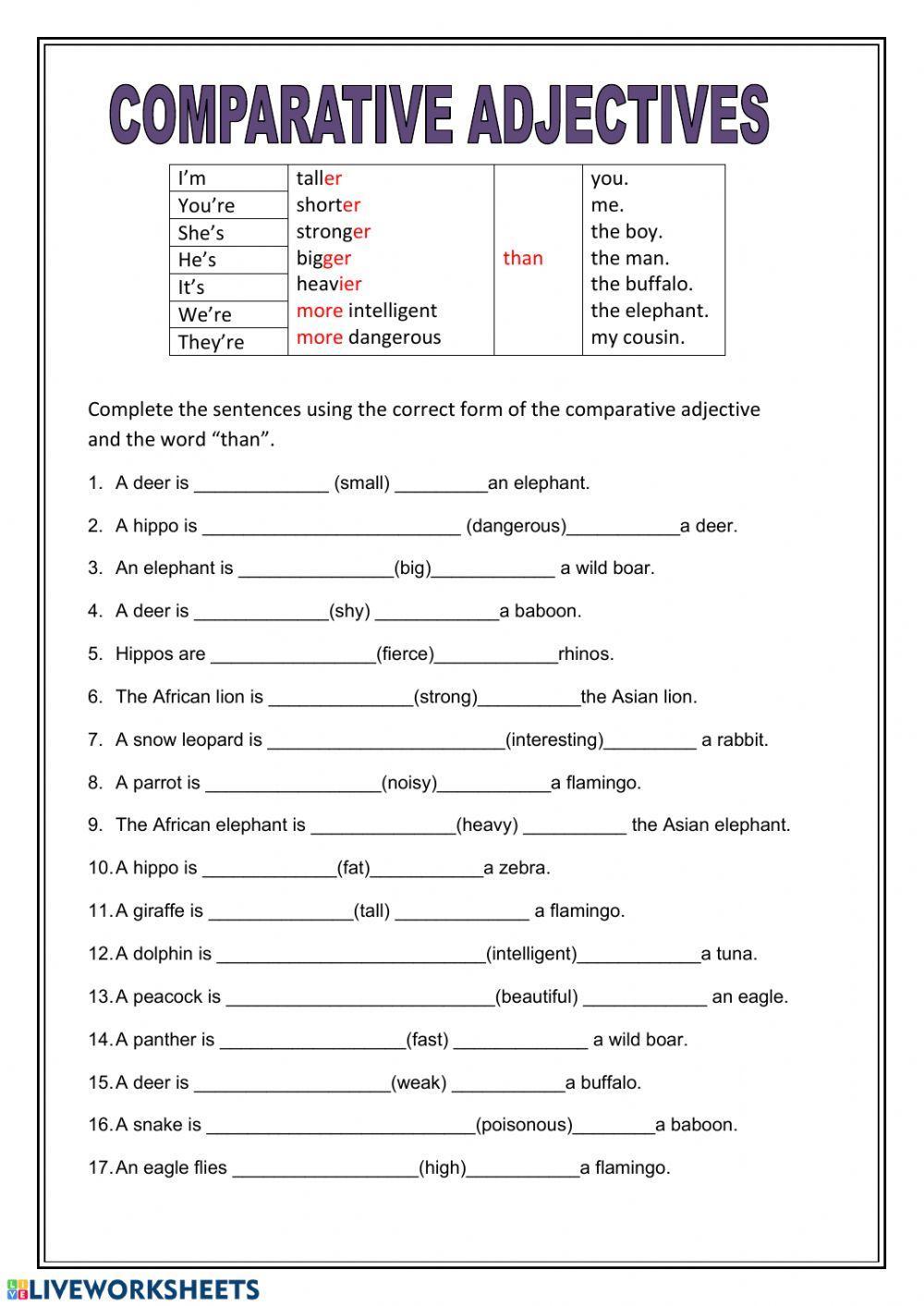
Mastering Nuance: The Indispensable Role of Comparative Adjectives Practice Worksheets
In the intricate tapestry of language, the ability to draw comparisons is not merely a stylistic choice but a fundamental necessity for clear and nuanced communication. Whether we are discussing the relative speeds of two animals, the beauty of different landscapes, or the complexity of various problems, comparative adjectives are our linguistic tools for highlighting differences. While the concept might seem straightforward, truly mastering the rules, exceptions, and fluid application of comparative adjectives requires dedicated effort and, crucially, consistent practice. This is where comparative adjectives practice worksheets become an invaluable resource for learners and educators alike.
This article will delve into the profound importance of comparative adjectives, explore why comparative adjectives practice worksheets are an indispensable tool in their mastery, discuss various types of exercises found within these worksheets, and offer insights into how to effectively utilize them for optimal learning outcomes.

Understanding Comparative Adjectives: The Basics

Before diving into the practice, let’s briefly recap what comparative adjectives are. Comparative adjectives are words used to compare two nouns (people, places, things, ideas) and show which one has more or less of a particular quality. They typically answer the question "which is more X?" or "which is less X?".

The formation of comparative adjectives generally follows a few key rules:

- Short Adjectives (1-2 syllables, especially those ending in -y): Add "-er" to the end.
- tall becomes taller
- happy becomes happier (note the ‘y’ changes to ‘i’)
- big becomes bigger (note the doubling of the consonant)

- Long Adjectives (2+ syllables): Use "more" before the adjective.

- beautiful becomes more beautiful
- difficult becomes more difficult

- Irregular Adjectives: These do not follow the standard rules and must be memorized.
- good becomes better
- bad becomes worse
- far becomes farther or further
- little becomes less
- much/many becomes more


Often, when using comparative adjectives, we also use the word "than" to connect the two items being compared (e.g., "Mount Everest is taller than Mount Kilimanjaro").
Why Comparative Adjectives Practice Worksheets Are Indispensable
While understanding the rules is the first step, internalizing them and being able to apply them fluently in speaking and writing requires repetition and varied exposure. This is precisely why comparative adjectives practice worksheets are so crucial. Here’s a breakdown of their benefits:
- Structured Reinforcement: Worksheets provide a structured environment for learners to repeatedly apply the rules. This repetition is key to moving knowledge from short-term to long-term memory.
- Targeted Practice: They allow learners to focus specifically on comparative adjectives without the distraction of other grammatical concepts. This isolation helps solidify understanding.
- Identification of Weaknesses: As learners complete exercises, they (or their instructors) can easily identify which rules or irregular forms are causing difficulty, allowing for targeted remediation.
- Variety of Exercise Types: Good worksheets offer diverse exercise formats, catering to different learning styles and ensuring comprehensive practice. This prevents boredom and keeps the learning engaging.
- Self-Paced Learning: Learners can work through worksheets at their own pace, reviewing concepts as needed without the pressure of a classroom setting.
- Measurable Progress: Completing worksheets provides tangible evidence of progress, boosting confidence and motivating learners to continue.
- Teacher Resource: For educators, well-designed worksheets are time-savers, offering ready-made activities for practice, homework, or assessment.
Types of Exercises Found in Comparative Adjectives Practice Worksheets
The effectiveness of comparative adjectives practice worksheets lies in their versatility. Here are some common and highly effective exercise types you’ll encounter:
-
Basic Fill-in-the-Blanks:
- Example: "The elephant is (big) _____ than the mouse." (Answer: bigger)
- Purpose: Tests basic rule application and spelling changes.
-
Sentence Transformation:
- Example: "The old car is slow. The new car is fast." -> "The new car is (fast) _____ than the old car." (Answer: faster)
- Purpose: Requires understanding the meaning of the original sentences and applying the comparative form correctly within a new structure.
-
Error Correction:
- Example: "My brother is more tall than me." (Answer: taller)
- Purpose: Develops critical thinking and an eye for common mistakes (e.g., using "more" with short adjectives).
-
Picture Comparison:
- Example: Two pictures are shown – one of a small dog and one of a large dog. Students are asked to write sentences comparing them.
- Purpose: Connects grammar to visual cues, making the learning more concrete and applicable to real-world observation.
-
Open-Ended Writing Prompts:
- Example: "Compare two cities you know, focusing on aspects like size, weather, cost of living, and attractions."
- Purpose: Encourages creative application of comparative adjectives in extended writing, fostering fluency and more complex sentence structures.
-
Multiple Choice Questions:
- Example: "Which sentence is correct? a) He is more cleverer than she. b) He is cleverer than she. c) He is more clever than she." (Answer: b or c, depending on dialectal preference for ‘cleverer’ vs ‘more clever’)
- Purpose: Quick assessment of understanding, often good for identifying common errors.
-
Matching Exercises:
- Example: Match regular adjectives with their comparative forms, or match adjectives with their irregular comparative forms (e.g., "good" -> "better").
- Purpose: Reinforces memorization, especially for irregular forms.
-
Contextual Cloze Passages:
- Example: A short story or paragraph with blanks where students need to insert the correct comparative adjective based on the context.
- Purpose: Develops contextual understanding and the ability to choose the most appropriate comparative form.
Maximizing the Effectiveness of Comparative Adjectives Practice Worksheets
Simply completing a worksheet isn’t enough; how it’s used significantly impacts learning. Here are strategies for getting the most out of comparative adjectives practice worksheets:
- Start Simple, Progress to Complex: Begin with basic recognition and formation exercises. Once those are mastered, move on to more challenging tasks like sentence transformation, error correction, and open-ended writing.
- Provide Clear Instructions: Ensure learners understand exactly what is expected of them for each exercise.
- Offer Immediate Feedback: Whether through an answer key or teacher correction, prompt feedback is crucial. It allows learners to correct mistakes while the concept is fresh in their minds.
- Review and Reteach: If a learner consistently makes the same errors, review the relevant rule or irregular form before providing more practice.
- Integrate with Speaking and Listening: Don’t let practice be confined to paper. After completing worksheets, encourage learners to use comparative adjectives in discussions, debates, or descriptions of objects around them.
- Focus on Common Errors: Pay special attention to pitfalls like adding "more" to an "-er" adjective ("more taller") or misremembering irregular forms. Design specific exercises to target these issues.
- Make it Relevant and Engaging: Whenever possible, use content that is interesting and relevant to the learners’ lives or current events. Comparing popular culture figures, sports teams, or local landmarks can be more engaging than abstract examples.
- Encourage Self-Correction: Instead of just giving the answer, prompt learners to explain why their answer was incorrect and which rule they violated. This fosters deeper understanding.
Common Pitfalls and How Worksheets Address Them
The journey to mastering comparative adjectives is often riddled with common errors. Worksheets are specifically designed to highlight and help learners overcome these hurdles:
- "More" + "-er" Error: This is perhaps the most frequent mistake ("more bigger," "more taller"). Worksheets with error correction exercises directly target this by presenting incorrect sentences for learners to fix.
- Forgetting Irregular Forms: Learners might correctly apply rules to regular adjectives but stumble on "good/better" or "bad/worse." Dedicated matching or fill-in-the-blank exercises focusing solely on irregular forms help commit them to memory.
- Spelling Changes: Adjectives ending in -y (happy -> happier) or those with a CVC pattern (big -> bigger, hot -> hotter) require specific spelling rules. Worksheets often include exercises specifically designed to practice these spelling transformations.
- Confusion with Superlatives: While not the focus here, learners sometimes confuse comparative (comparing two) with superlative (comparing three or more). Well-designed worksheets focus exclusively on comparatives, reinforcing the distinction. Later, a mixed comparative adjectives practice worksheets and superlative adjectives practice worksheets can be introduced.
Finding and Creating Effective Worksheets
A plethora of resources exists for comparative adjectives practice worksheets. Online educational platforms, ESL (English as a Second Language) websites, and published grammar textbooks are excellent starting points. Many websites offer free printable worksheets that can be customized or used as is. Teachers can also create their own worksheets tailored to the specific needs and interests of their students, ensuring the content is highly relevant and engaging.
When selecting or creating worksheets, consider:
- The target audience’s proficiency level.
- The variety of exercise types included.
- The clarity of instructions and examples.
- The provision of an answer key for self-correction.
Conclusion
The ability to compare and contrast is a cornerstone of sophisticated communication in English. Comparative adjectives allow us to paint vivid pictures of differences, express preferences, and convey nuanced information. While the rules for their formation are logical, true mastery demands consistent, deliberate practice. This is precisely where comparative adjectives practice worksheets prove their invaluable worth.
By offering structured, varied, and targeted exercises, these worksheets serve as an indispensable tool for learners to internalize rules, overcome common pitfalls, and build the confidence necessary to use comparative adjectives fluently and accurately. Whether you are a student striving for grammatical precision or an educator seeking effective teaching resources, embracing the power of comparative adjectives practice worksheets is a sure path to linguistic excellence. Through diligent engagement with these materials, the journey from understanding to application becomes not just possible, but genuinely enjoyable and highly rewarding.
